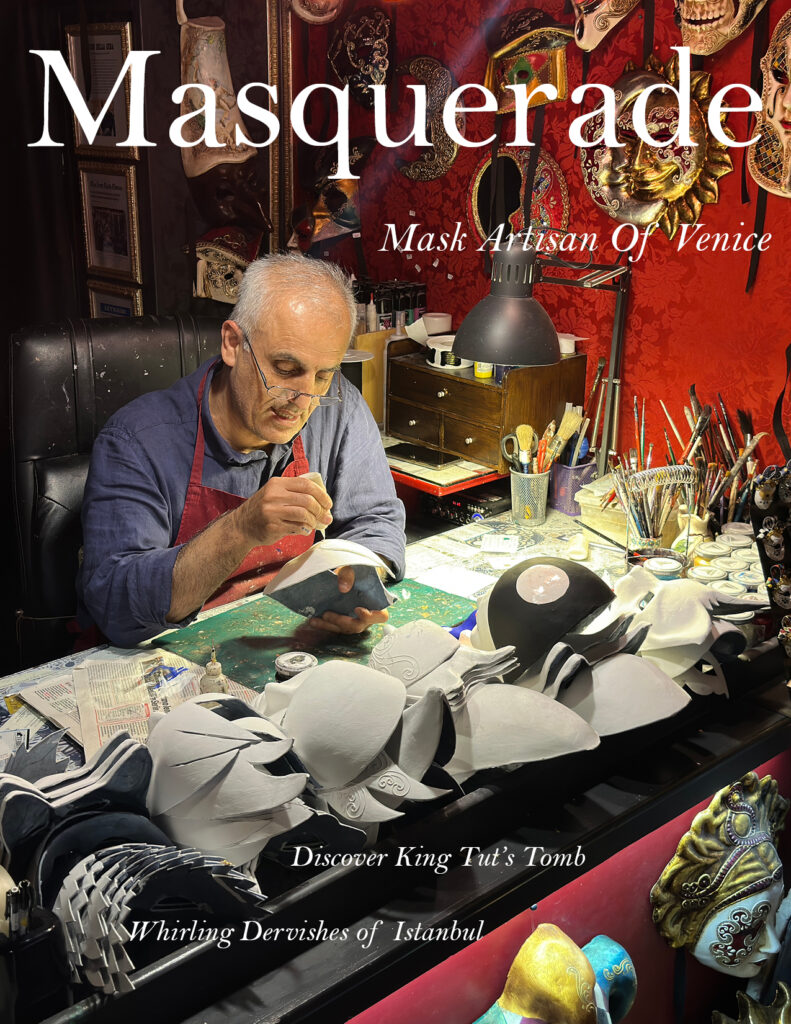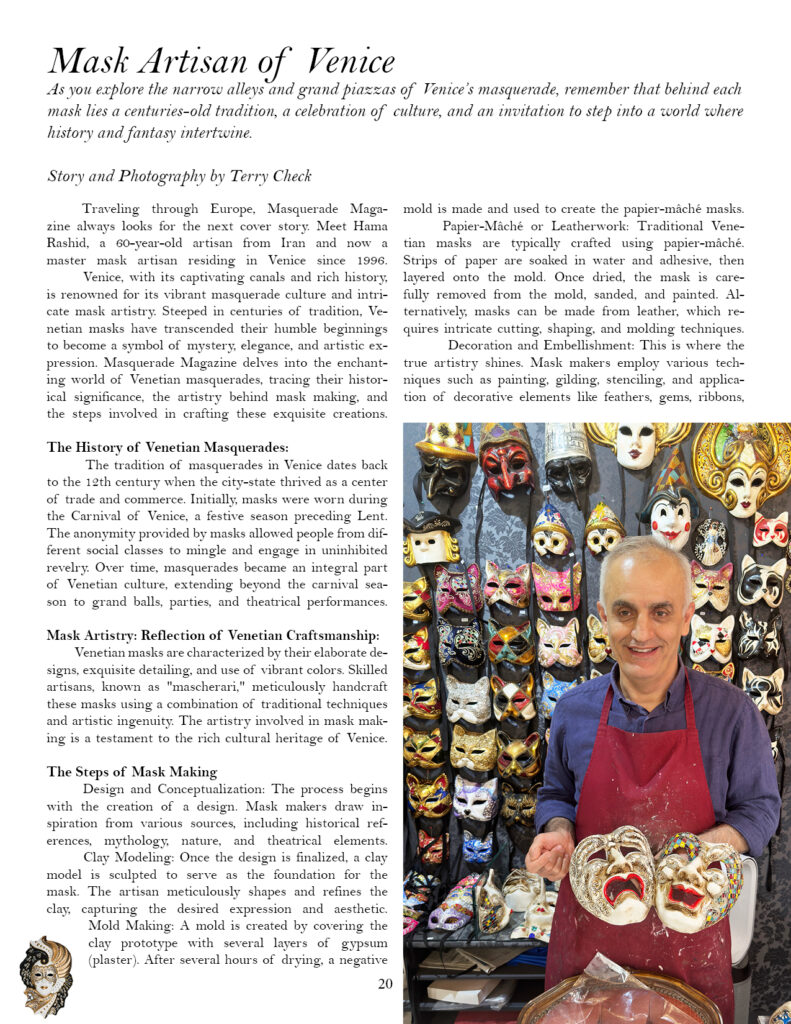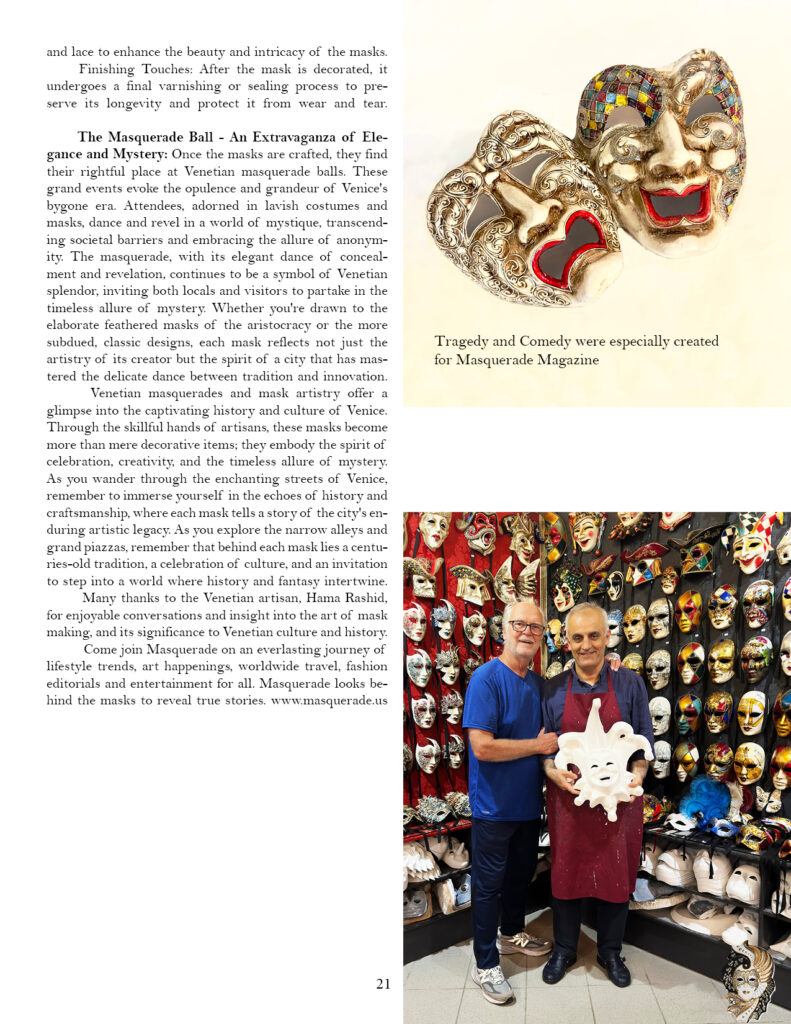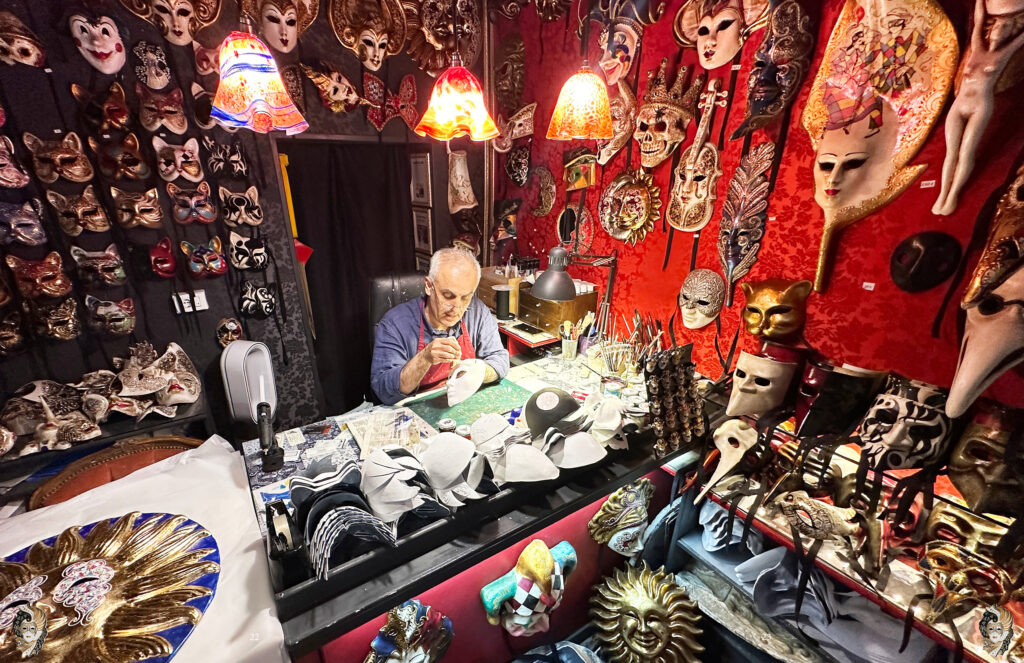As you explore the narrow alleys and grand piazzas of Venice’s masquerade, remember that behind each mask lies a centuries-old tradition, a celebration of culture, and an invitation to step into a world where history and fantasy intertwine.

Story and Photography by Terry Check
Traveling through Europe Masquerade, Magazine always looks for the next cover story. Meet Hama Rashid, a 60-year-old artisan from Iran and who has evolved into a master mask artisan residing in Venice since 1996.
Venice, with its captivating canals and rich history, is renowned for its vibrant masquerade culture and intricate mask artistry. Steeped in centuries of tradition, Venetian masks have transcended their humble beginnings to become a symbol of mystery, elegance, and artistic expression. Masquerade Magazine delves into the enchanting world of Venetian masquerades, tracing their historical significance, the artistry behind mask making, and the steps involved in crafting these exquisite creations.

The History of Venetian Masquerades: The tradition of masquerades in Venice dates back to the 12th century when the city-state thrived as a center of trade and commerce. Initially, masks were worn during the Carnival of Venice, a festive season preceding Lent. The anonymity provided by masks allowed people from different social classes to mingle and engage in uninhibited revelry. Over time, masquerades became an integral part of Venetian culture, extending beyond the carnival season to grand balls, parties, and theatrical performances.
Mask Artistry: A Reflection of Venetian Craftsmanship: Venetian masks are characterized by their elaborate designs, exquisite detailing, and use of vibrant colors. Skilled artisans, known as “mascherari,” meticulously handcraft these masks using a combination of traditional techniques and artistic ingenuity. The artistry involved in mask making is a testament to the rich cultural heritage of Venice.

The Steps of Mask Making:
Design and Conceptualization: The process begins with the creation of a design. Mask makers draw inspiration from various sources, including historical references, mythology, nature, and theatrical elements.
Clay Modeling: Once the design is finalized, a clay model is sculpted to serve as the foundation for the mask. The artisan meticulously shapes and refines the clay, capturing the desired expression and aesthetic.
Mold Making: A mold is created by covering the clay prototype with several layers of gypsum (plaster). After several hours of drying, a negative mold is made and used to create the papier-mâché masks.

Papier-Mâché or Leatherwork: Traditional Venetian masks are typically crafted using papier-mâché. Strips of paper are soaked in water and adhesive, then layered onto the mold. Once dried, the mask is carefully removed from the mold, sanded, and painted. Alternatively, masks can be made from leather, which requires intricate cutting, shaping, and molding techniques.
Decoration and Embellishment: This is where the true artistry shines. Mask makers employ various techniques such as painting, gilding, stenciling, and application of decorative elements like feathers, gems, ribbons, and lace to enhance the beauty and intricacy of the masks.
Finishing Touches: After the mask is decorated, it undergoes a final varnishing or sealing process to preserve its longevity and protect it from wear and tear.
The Masquerade Ball – An Extravaganza of Elegance and Mystery: Once the masks are crafted, they find their rightful place at Venetian masquerade balls. These grand events evoke the opulence and grandeur of Venice’s bygone era. Attendees, adorned in lavish costumes and masks, dance and revel in a world of mystique, transcending societal barriers and embracing the allure of anonymity. The masquerade, with its elegant dance of concealment and revelation, continues to be a symbol of Venetian splendor, inviting both locals and visitors to partake in the timeless allure of mystery. Whether you’re drawn to the elaborate feathered masks of the aristocracy or the more subdued, classic designs, each mask reflects not just the artistry of its creator but the spirit of a city that has mastered the delicate dance between tradition and innovation.
Venetian masquerades and mask artistry offer a glimpse into the captivating history and culture of Venice. Through the skillful hands of artisans, these masks become more than mere decorative items; they embody the spirit of celebration, creativity, and the timeless allure of mystery. As you wander through the enchanting streets of Venice, remember to immerse yourself in the echoes of history and craftsmanship, where each mask tells a story of the city’s enduring artistic legacy. As you explore the narrow alleys and grand piazzas, remember that behind each mask lies a centuries-old tradition, a celebration of culture, and an invitation to step into a world where history and fantasy intertwine.

Many thanks to the Venetian artisan, Hama Rashid for enjoyable conversations and insight into the art of mask making, and the significance to Venetian culture and history. Come join Masquerade Magazine on an everlasting journey of lifestyle trends, art happenings, worldwide travel, fashion editorials and entertainment for all. Masquerade Magazine, www.masquerade.us, looks behind the masks to reveal true stories.